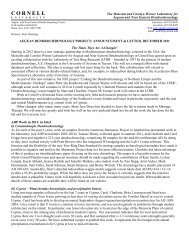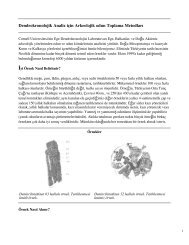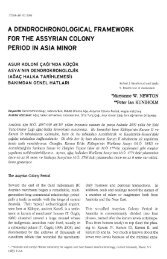Aegean Dendrochronology Project December 2004 Progress Report
Aegean Dendrochronology Project December 2004 Progress Report
Aegean Dendrochronology Project December 2004 Progress Report
You also want an ePaper? Increase the reach of your titles
YUMPU automatically turns print PDFs into web optimized ePapers that Google loves.
<strong>Aegean</strong> <strong>Dendrochronology</strong> <strong>Project</strong> <strong>December</strong> <strong>2004</strong> <strong>Progress</strong> <strong>Report</strong><br />
IRON-AGE GORDION: In the<br />
summer of 2003 the Gordion Excavation<br />
team called to ask us not to forget to come<br />
collect some newly discovered wood. As<br />
Ken Sams (UNC-Chapel Hill) prepared the<br />
monumental Phrygian Gate for grouting,<br />
he found a line of some 20 juniper logs<br />
visible under the east face of the wall<br />
where they had been buried under a pile of<br />
loose fill (directly behind my shadow in<br />
the first photograph) since Rodney Young<br />
excavated the gate in the 1950s. They had<br />
been laid as a row of headers or as a kind<br />
of leveling course to support the weight of<br />
the dry-stone masonry. We could get at<br />
four of them, sort of, but two hours' hand<br />
sawing got us nowhere.<br />
Finally we used a chainsaw, not normally an instrument for delicate archaeological extraction.(Long-term readers of these<br />
<strong>Report</strong>s might remember the Lygos tree from the Samian Heraion which had to be sampled the same way.) Out came the<br />
sections, and they were almost immediately dated. The last existing ring (no bark preserved) is 862 BC. The Phrygian<br />
palace enclosure wall and gate thus appear to be a ninth-century affair. A multi-authored monograph setting forth the<br />
particulars of a complete re-thinking of Phrygian Gordion's development and history is in preparation to appear next year.<br />
IRON-AGE ASSIROS: The Bronze Age-Iron Age mound of Assiros (left), just north of Thessaloniki, was excavated<br />
in the late 1980s by Dr. Ken Wardle (University of Birmingham). He kindly provided us with oak charcoal from the Iron<br />
Age destruction (center), and now we are able to report dendrochronological results, backed up by radiocarbon<br />
1
wiggle-matching, which for the first time ever allow us to date a well-known class of ceramic artifact. The Protogeometric<br />
pot below (right) was sealed between two floors (Phases 2 and 3), each dated by tree-rings. We have reported the date of the<br />
appearance of this pot to at least 1070 BC, some 50 years earlier than conventionally assumed (watch for the forthcoming<br />
proceedings of the AEMΘ seminar in Thessaloniki and the Iron Age Symposium at Oxford). The date prompts many<br />
questions and needs to be followed up by complete analysis of Assiros site stratigraphy through the Mycenaean period, but<br />
we feel that this result offers just the kind of thing for which many colleagues have been hoping.<br />
GAZIPAŞA FORESTS: On top of a rocky mountain peak (Karatepe forest district) above Selinus in Rough Cilicia is<br />
a forest of cedar, juniper, fir, and pine which<br />
colleague Prof. Nicholas Rauh (Purdue University)<br />
told us about some years ago. Without Nick handy to<br />
guide us we stumbled our way up to the fire tower.<br />
The peak must be one of the ones illustrated by<br />
Admiral Francis Beaufort (as in the 'Beaufort Scale')<br />
in 1817, and all the trees we sampled were already<br />
growing at that time.<br />
Although Beaufort's pen-and-ink drawing (Click on<br />
drawing to see larger 1.2MB version) makes the<br />
Taurus look like something out of Li'l Abner, his<br />
prose backs it up: "The hill and cape of Selinty rises<br />
steeply from the plain on one side, and breaks off into a<br />
chain of magnificent cliffs on the other:...and behind all,<br />
a prodigious range of mountains, whose black sides,<br />
having already lost the evening sun, formed a singular<br />
contrast with their snowy tops. We also had a distinct<br />
view of the island of Cyprus rising from the southern<br />
horizon, though not less than seventy miles distant."<br />
Our view down (below) is from the peak on the skyline<br />
on the extreme right of Beaufort's drawing. Thanks to<br />
modern pollution Cyprus was somewhat hazy in the<br />
distance.<br />
The cedars, at least the ones we found, were not quite as<br />
old as Nick had claimed, but next to the fire tower on<br />
the mountaintop were the remains of a Roman logging<br />
camp. I had thought he had been exaggerating about any<br />
Roman presence until I found a piece of terra sigillata in one of the crevices in the rock.<br />
2
We have reported in previous years the results of a number of forays to cedar (and other) forests around the periphery of<br />
the eastern Mediterranean. (Click on map for a legible version.)<br />
The goal, as always, was to ensure that the link that we have always<br />
thought we had between Anatolian cedars and Lebanese cedars (and by<br />
implication with Egyptian cedar wood) was legitimate. One problem<br />
with the provenience of cedar found in Egyptological collections is<br />
that the Egyptians seem to have been vague about foreign geography.<br />
Imports come from the other side of the "Great Green." We do know<br />
that Byblos was one certain entrepot for cedar export, but since many<br />
inscribed Phoenician grave monuments have been found in Rough<br />
Cilicia, nowhere near any settlement, the best guess as to what<br />
Phoenicians were doing so far away from home is that they were in<br />
the cedar wood business, and when they died they were buried in<br />
place. So Cilicia is a candidate for the birthplace of at least some of<br />
the Egyptian cedar wood.<br />
The map to the right shows four conifer sites stretched along the 40th parallel. The numbers in the table show the<br />
crossdating scores. Since Mt. Pollino in Calabria and Batsara in Georgia are separated by some 2540 kms. (or Ithaca, NY,<br />
to Dallas, TX, if you do not like kilometers), and there are two seas in the middle, the fact that we get good long-distance<br />
crossdating is very satisfying. We note that the extremes do not match very well at all, but the step-wise fits are great. In<br />
the circled area around the northeast corner of the Mediterranean we have some 16 cedar forests alone, plus another dozen<br />
forests of juniper, pine, and fir. What Maryanne Newton has been doing is quantifying the fits between one forest and<br />
another. By the end of this academic year a number of the new data sets will also have been submitted to the International<br />
Tree-ring Data Bank in Boulder, Colorado. We announced a fit between Bronze Age Anatolian and Egyptian cedars last<br />
winter in Vienna. The 336-year Egyptian data set is currently being wiggle-matched to test the correctness of our proposed<br />
dendrochronological fit.<br />
timbers from filled-in doors and windows in the flank walls were<br />
almost immediately dated to 1726, but for 27 years we have had a<br />
213-year conifer data set that we have tried in vain to date.<br />
UNEXPECTED DIVIDENDS (BOTH GOOD AND<br />
BAD): Every now and then we report unexpected dividends. In<br />
1977 and 1979 in a collaboration with Prof. C. L. Striker<br />
(University of Pennsylvania), who did some of the photography<br />
below, we visited Chalkis in Euboea and sampled the church of<br />
Hg. Paraskevi. The structure is clearly Frankish, and the best<br />
historical bet for its date is after the seat of the Latin Patriarch<br />
was translated to Chalkis from Constantinople in 1261. Oak<br />
As Ramsay Traquair's 1923 plan shows, the church is a<br />
three-aisled affair with the nave arcade columns supporting the<br />
masonry of the clerestory walls. The two columns on the west<br />
front of the church that look from the photograph to be<br />
ornamental are nothing of the sort. They are a continuation of the nave arcade at exactly the right intercolumniation. When<br />
a 19th century earthquake brought down the west front of the building, the wall was rebuilt as shown on Traquair's plan,<br />
but this time inside the two columns, thereby severely truncating the length of the church. Of greater interest to us was the<br />
long row of joists spanning the nave. Were they from the 19th century? Or were they 13th-14th century?<br />
3
Traquair comments on the "heavy triangular wooden roof whose tie beams are supported by richly moulded brackets. It<br />
seems to be the original mediaeval roof." This question was answered fairly readily at the time of collection. After Mike<br />
Rafferty and I climbed ladders or suspended ourselves from a boatswain's chair attached to spelunking ropes, we could see<br />
something painted on the front of each bracket that supported the nave joists. After we had called for brushes with which to<br />
do a little discreet dusting, we could see winged lions of St. Mark holding the Bible, something Traquair had not spotted<br />
from below. So the woodwork was indeed Frankish. But the date remained out of reach until last month when we e-mailed<br />
the tree-ring data sets to Dr. Kurt Nicolussi at the University of Innsbruck. It took him overnight to fit Hg. Paraskevi<br />
against his Alpine larch chronology. The last existing ring is 1222, and there is part of the 1223 ring present. Since the<br />
timbers are heavily squared, I suspect that some 30 or 40 rings could easily be missing from the exterior of our dataset.<br />
Thus the connection with the 1261 event looks better and better.<br />
What this tells us is that not only did the Franks build in a manner familiar to them, but they also sent home for the huge<br />
larch beams with which to do it. We have had evidence of long-distance timber trade from the Black Sea to Istanbul and<br />
Thessaloniki in the 19th century back to the 14th century, from Venice to Dubrovnik in the 16th century, from the Alps<br />
to Herculaneum and Pompeii in the 1st century and earlier, and of course we find imported cedars and junipers in Egypt as<br />
far back as pre-Dynastic. times, so trade from Venice to Chalkis is no big surprise. That is the good news. The bad news is<br />
that Hg. Paraskevi does not help us with the <strong>Aegean</strong> in the 13th, 12th, and 11th centuries the way that we had hoped it<br />
might.<br />
4
Click on above image to see close-up including tree rings.<br />
UNEXPECTED DIVIDENDS (GOOD BUT ALSO MILDLY DISAPPOINTING): In 1999 we reported<br />
collecting several lots of wood from Ravenna that were supposed to be partly Augustan, partly second-century, and partly<br />
Late Roman. We reported that they did not seem to fit any of the published Alpine chronologies to which we then had<br />
access. Annie Koehne labored mightily to join two long sequences, one 364 years, and the other 265. Last summer we<br />
showed these to Dr. Nicolussi in Innsbruck, and in about five minutes we had dates. Ravenna is now a single sequence that<br />
runs from 419 BC to AD 182, a total of 601 years. So, finding Alpine wood in Ravenna is even less of a surprise than<br />
Hg. Paraskevi, and the Ravenna Soprintendente will be happy that her age estimates are confirmed, but this is no help for<br />
our AD/BC gap. Annie will be mollified to know that the actual overlap between her two sequences was only 21 years. We<br />
had noticed the fit but rejected it as impossibly short.<br />
A DIVIDEND ON A DIVIDEND: In 1974 the late Nezih Firatli gave me a fir plank from a Roman tomb in Turkish<br />
Thrace which he said could have been 1st, 2nd, or 3rd century. It really looks good against the Alpine sequences at 72 BC.<br />
Since the tomb is unpublished, and nobody alive knows which tomb Nezih Bey meant, this is unremarkable except that<br />
once again one notes that whenever the Romans needed anything: timber, marble, food, military supplies, and whatever<br />
else a civilized nation has to have, they got it from the best source. Oleg Grabar once said that the "Romans were the first<br />
people with a PX mentality," and I'll make sure he sees this note. Now that we have almost 1000 years' worth of Alpine<br />
conifers to which we may now refer, we are also looking at all our seaside sites with undated conifer ring-sequences to see<br />
what else might be an import from up north.<br />
UNEXPECTED DIVIDENDS (GOOD): Last May the Turkish Directorate General of Monuments and Antiquities<br />
decided to hold its annual archaeological symposium in Konya. As we prepared our 2003-<strong>2004</strong> paper, we realized we had a<br />
baker's dozen of monuments in or near Konya that we had sampled in previous years and sometimes successfully dated, so<br />
just for fun we put together a poster with captions in Turkish which was very well received by our hosts. Enclosed with<br />
this mailing (for all active Patrons and with a small supply held in reserve for new Patrons) is the poster, but reduced to a<br />
manageable size, and with the captions loosely translated back into English. Readers over the age of 25 may find a<br />
magnifying glass helpful in its interpretation. (Readers of this web-page may eventually find the poster's contents available<br />
through a link right here....)<br />
A LONG-AWAITED ONE-TIME DIVIDEND (BEST OF ALL): Maryanne Newton who for years has been our<br />
Jane-of-all-trades (you see her below at Bronze Age Kültepe with Kutlu Emre, in the Egyptian Department of the<br />
Metropolitan Museum with Hathor, at Byzantine Ohrid where the tie-beam she is drilling had a 220-volt live electrical<br />
cable embedded in it, and at Urartian Ayanis) defended her dissertation and is now Dr. Newton. She is a full-time Research<br />
Associate with us and is busily fulfilling a half-dozen publication obligations as well as serving as the NSF-supported<br />
leader of the Roman Gap <strong>Project</strong> work. She has also been invited to give her maiden paper at the AIA Meetings in Boston<br />
5
in January 2005 on the Uluburun shipwreck.<br />
NEUTRON ACTIVATION ANALYSIS: After a long delay caused by the closing of the Ward Center on the<br />
Cornell campus, our tree-rings from Turkey and Greece (and, in the near future, from southern California and perhaps<br />
Poland as well) are now being measured by Professor Kenan Ünlü and Danielle Hauck at Penn State's 1-Megawatt<br />
Breazeale Reactor. Danielle has so far measured every ring from 1411 to present (and she could not have done that unless<br />
Pam Sullivan, Meg Underwood, and Karola Kirsanow had not cut them up into one-year slices in advance). One toy which<br />
Danielle has in her new lab is a "rabbit." Remember the department stores that used to have a vacuum tube that took your<br />
money to the cashier and then brought you your change? Danielle's rabbit gulps a new sample and puts it inside the reactor<br />
inside of a second. Then she can recall it and pop it in the counter. For measuring elements with a short half-life, say two<br />
and a half minutes, this is a major step forward. She has been getting interesting traces of gold, silver, and lanthanum, the<br />
latter, I confess, an element I had never heard of until two months ago. I had hoped to be able to report to you in this<br />
newsletter the results from the NAA analysis of the enormous rings from Porsuk that we date to 1650 BC and the years<br />
immediately following. If, as I believe, they were volcanically induced, the array of trace elements should show up<br />
splendidly in Danielle's multi-channel analyzer. Kenan Bey and Danielle are promising results by the end of this month.<br />
MISCELLANEOUS: Work on the Roman Gap <strong>Project</strong> continues apace, despite temporary setbacks with the Alpine<br />
larch. The 6th century Byzantine church at Vize has a 1st century piece of reused Roman wood in it which helps explain<br />
why it never fit anything else from the 6th century. The estimated date for the wood found in the North Agora at<br />
Aphrodisias in 2003 turned out to be well over a century younger than the expected circa AD 700 date. We have a number<br />
of placements on which we will report this coming spring. Bernd Kromer and Sahra Talamo at Heidelberg continue to<br />
produce high-precision radiocarbon dates for the ten-year segments we keep sending them. Sturt Manning has saved us vast<br />
sums by moving to Toronto where the telephone charges are much cheaper than from here to England. Carol Griggs will<br />
report at the <strong>December</strong> meeting of the American Geophysical Union on "Regional reconstruction of the Palmer Drought<br />
Severity Indices and precipitation in the north <strong>Aegean</strong> and northwestern Turkey from an oak tree-ring chronology, AD<br />
1169-1985." That has meant her re-checking the entire oak record for the last 800 years. Stalwart team members during the<br />
summer were Nicole Riches, Maryanne Newton, and Kelly Cook. Pam Sullivan went off to law school, and Nicole Riches<br />
has moved into her slot as lab boss. Kit Sturgeon is the new Systems Administrator, replacing Muhammad Arif. Finally,<br />
the year's most noteworthy achievements in the dendrochronology of the <strong>Aegean</strong> Bronze Age are the 2009-year chronology<br />
announced last <strong>December</strong> and published this past summer in the Turkish National Science Foundation's Braidwood<br />
Memorial Volume, an offprint of which most readers of this newsletter will have received by now. In the February 2005<br />
supplement of Der Anschnitt will appear the tree-ring indices for every single year of the second millennium BC based on<br />
an average of over 42 trees per year for a thousand years. We'll save an offprint for you.<br />
6
Peter Ian Kuniholm<br />
CORNELL UNIVERSITY<br />
Back to Index<br />
last modified 17 Jan 2005 mjb<br />
P.S.:Pam and Nicole have<br />
presided over a full house of<br />
undergraduates each semester,<br />
aided by oldtimers Alison<br />
Petrucci, Elizabeth Emrich,<br />
Joyce Feuille, Christofili<br />
Kefalas, Beth Smoot, John Choi,<br />
and Tania Lemos. Mary Jaye<br />
Bruce has returned to edit text and<br />
scan the photographic archive.<br />
Little of what is reported here<br />
could have been done without<br />
their help.<br />
7








